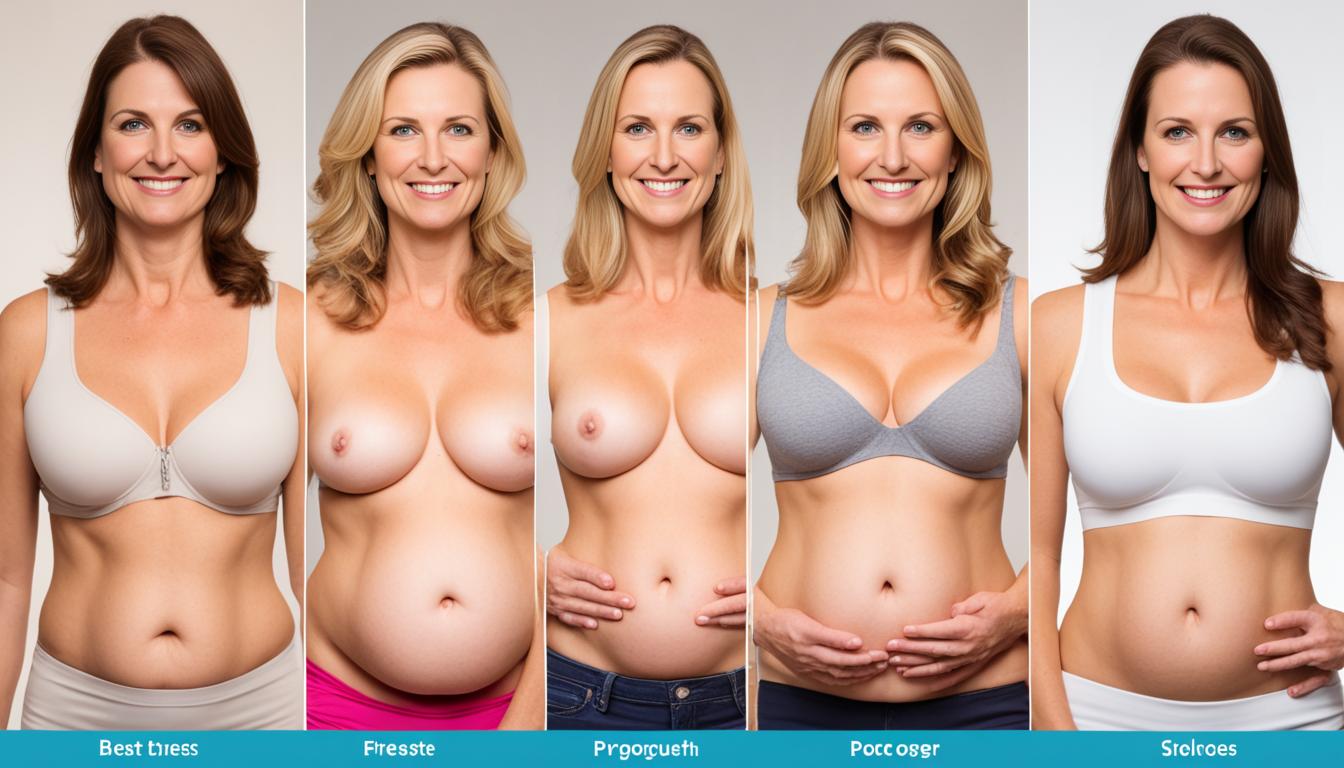Our bodies change a lot as we age, and these changes are often seen in our breasts. I remember being excited as my breasts grew during puberty. Later, I saw them change again through pregnancy and breastfeeding. Now, I find myself asking, “How does getting older impact breast size?” This guide will explore how breasts change as time goes on.
Key Takeaways
- Breasts start forming during fetal development, with milk ducts forming as part of a baby’s growth.
- Puberty brings about significant changes, as breasts get bigger and the mammary glands prepare for potential pregnancy.
- Pregnancy and breastfeeding cause further alterations, with breasts growing larger and the nipples increasing in size and darkening in color.
- As we age, our bodies produce fewer reproductive hormones, leading to changes in the texture and shape of the breasts.
- Lifestyle factors, such as body weight, sun exposure, and smoking, can also influence breast size and shape over time.
Understanding Breast Development and Growth
Breasts are key in women’s bodies, shaped by changing hormones throughout their lives. Knowing about breast formation can help understand their growth. This offers insights into how breasts change with age.
Breast Formation During Fetal Development
The story of breast growth actually starts before birth. In the womb, a baby’s milk ducts begin to form. They grow as part of the body’s normal development. But, they won’t fully develop until later in life.
Changes During Puberty and Adolescence
Puberty triggers many changes, including breast growth. During this phase, breasts get larger. The body also prepares for potential pregnancy by readying the mammary glands to make milk.
Influence of Pregnancy and Breastfeeding
Pregnancy and breastfeeding add more changes. In preparation to feed a baby, breasts often grow bigger. The nipples might also get larger and darker. Milk ducts become active, producing milk.
Common Age-Related Breast Changes
Our bodies go through changes as we age, including our breasts. These changes are part of getting older. We will look at what may happen to your breasts over time.
Changes in Breast Size
Breast size can change a lot as you age. This happens because of hormone fluctuations and less breast tissue. You might notice your breasts getting smaller or sagging more.
Alterations in Breast Shape
Breast shape also changes with age. They might lose their perkiness and start to sag. This change is caused by a loss of elasticity in the skin and breast tissue.
Fluctuations in Breast Firmness
As the years go by, breasts may feel less firm. They become softer and not as dense. This softening is perfectly normal as you age.
Nipple and Areola Modifications
Nipples and areolas can also change over time. Nipples might get larger, and areolas could expand. These alterations are normal and usually not a sign of health problems.
Realize that these changes in your breasts are normal and no cause for worry. Unless they cause you discomfort or seem unhealthy, you may not need to visit a doctor. Accepting these changes and taking care of yourself can boost your confidence.
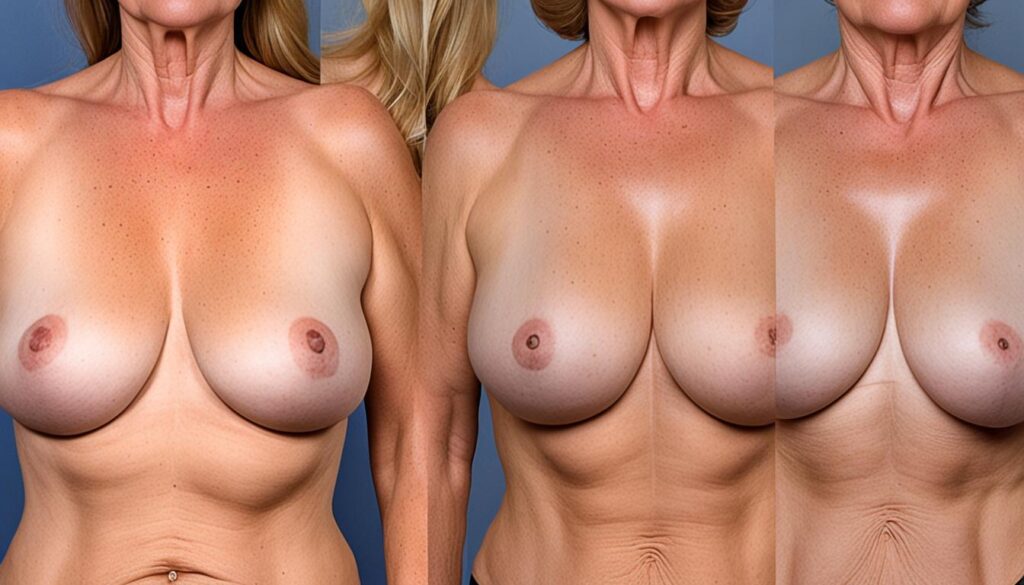
The Role of Hormones in Breast Size
Hormones, such as estrogen and progesterone, hugely influence our breasts. Over time, our bodies make less of these hormones. This change can alter our breasts’ texture and shape.
Estrogen and Breast Tissue Growth
Estrogen is key for growing breast tissue. In puberty, it makes milk ducts grow and adds fat to our breasts. This makes them bigger. But, as we grow older, less estrogen means our breast tissue might shrink a bit.
Hormonal Shifts During Menopause
Menopause causes big changes in breast size and shape as estrogen and progesterone levels fall. Breasts might get smaller and look less full as time goes on. Knowing about hormones helps us understand these changes as we age.
How does age affect breast size?
As we age, the body slows down making reproductive hormones. This can make our breasts change in texture and shape. The major changes come from less estrogen and less elastic skin.
Low Estrogen Levels and Breast Tissue Changes
Estrogen is key for keeping breast tissues robust and full. Since estrogen levels drop during menopause, breasts may lose volume and firmness. This can make breasts appear smaller and less dense over time.
Skin Elasticity and Breast Sagging
The loss of skin’s stretchiness is a big deal too. Collagen and elastin fibers lessen, making breasts sag more. Even without a size change, breasts might look droopy or flat.
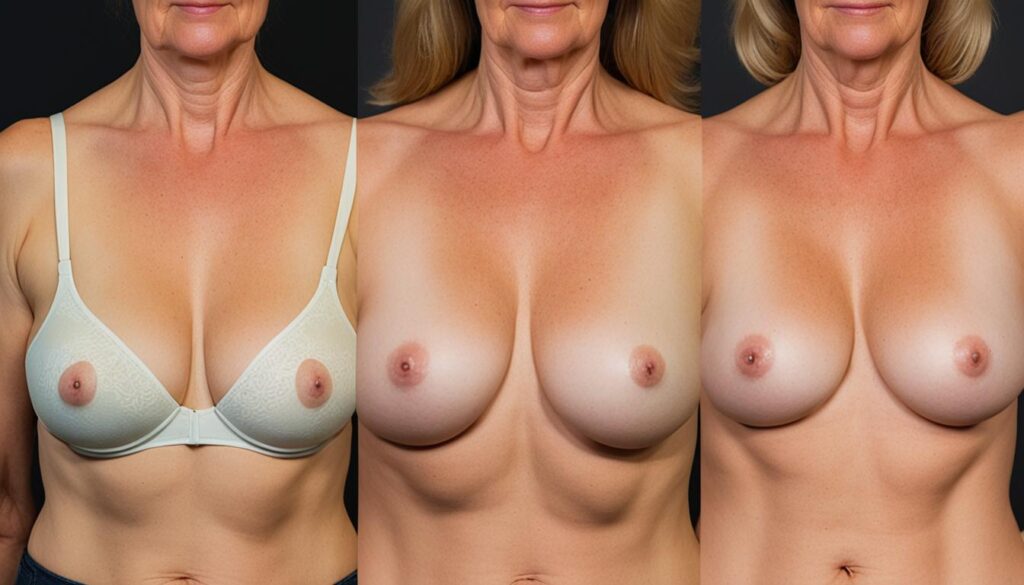
Breast Changes and Potential Health Concerns
As I grow older, it’s key to note that not every breast change is just aging. Some changes might mean there’s a health issue, like breast cancer. Doing regular self-checks and seeing the doctor often can help spot any worrisome signs early. This way, I can deal with them quickly.
Signs to Watch for and When to See a Doctor
Breasts can naturally sag or feel less firm with age. But, I must watch for any sudden lumps, odd discharge, skin changes, or uneven breasts. Noticing these signs means I should see my doctor soon. They can check if it’s something serious or not.
Breast Cancer Risk and Age-Related Factors
My risk for breast cancer goes up as I age. The CDC says most cases happen after 50. Also, the Office on Women’s Health notes that menopause usually starts at 52 in the U.S. These age factors are important. They make regular checks and staying alert key for keeping my breasts healthy.

Staying on top of my breast health is essential as I get older. This includes self-checks and doctor visits. It helps manage changes and find any concerns early. So, I can stay as healthy as possible.
Managing Age-Related Breast Changes
As we age, our breasts naturally change in shape and appearance. But, you can work to manage and improve these changes. Strategies include wearing supportive bras, exercising, and even considering surgery.
Supportive Bras and Breast Lift Options
Finding a supportive bra that fits well is key. It can lift and support your breasts, making them look better under clothes. You can get help choosing the right bra at specialty stores. If you want more significant changes, a breast lift might be an option.
Exercises for Firmer Breasts
Exercising your chest and upper body can maintain breast firmness. Activities like push-ups and chest presses help. Adding these exercises to your routine can make your breasts look perkier and more youthful.
Surgical Interventions: Breast Lift and Implants
Surgery is an option for more noticeable changes. A breast lift can raise and reshape your breasts. Breast implants add volume for a fuller look. Discussing these options with a plastic surgeon is important to decide what’s best for you.
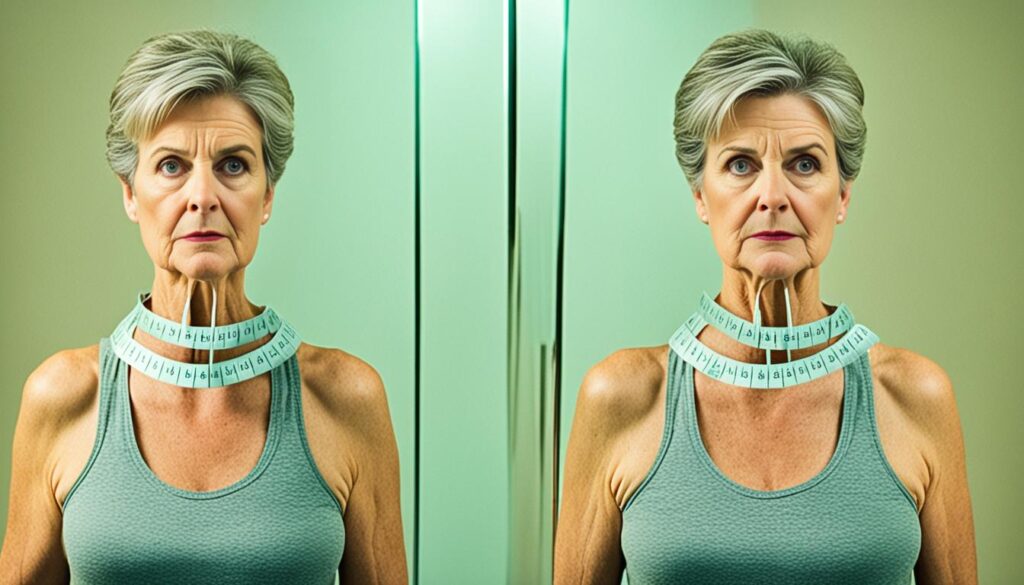
Lifestyle Factors Influencing Breast Size and Shape
Our age and the choices we make can change our breasts. This happens over time. Healthy living is important for how our breasts look as we grow older.
The Role of Body Weight and Body Fat
How much we weigh and our body fat % affect our breasts. More body fat can make breasts bigger. On the other hand, less body fat can make breasts smaller.
Being healthy helps keep breasts at a good size. That means exercising and eating well. This leads to better breast health and stable sizes over time.
Impact of Sun Exposure and Smoking
Too much sun and smoking can hurt breast tissue. Sun makes skin old too quickly. This can cause sagging.
Smoking also makes skin less elastic and can cause breasts to sag. To keep your breasts looking youthful, avoid too much sun and don’t smoke.
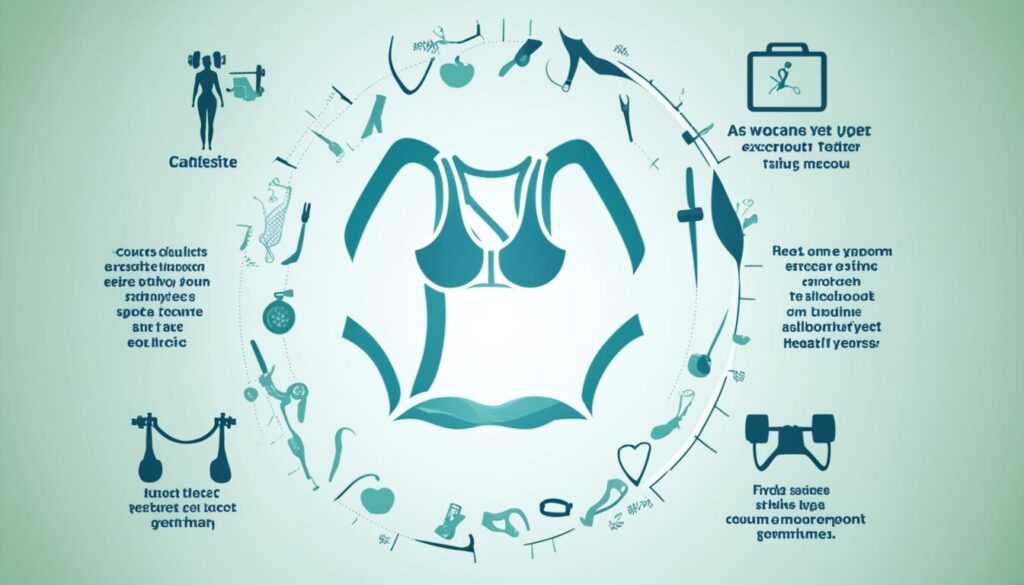
Early Life Influences on Breast Development
Research shows early life matters for women’s breasts. Things like birth weight and pubertal growth patterns impact breast-tissue composition and density. It’s important because these factors affect breast changes over time and breast growth.
Birth Weight and Breast Tissue Composition
Higher birth weights link to more breast-tissue composition and density later on. This suggests things during early life shape breast development and growth for years.
Pubertal Growth and Breast Density
The pace of pubertal growth matters for breast density in young women. Fast growth and early breast development lead to higher breast density. This affects breast health as time goes on.

Conclusion
As we get older, our breasts naturally change in size, shape, and look. This mainly happens because our hormone levels change. They drop, especially estrogen, as time goes on. Things like how much we weigh, what we do, and our early life can also have a say in how our breasts grow and change over our lives.
Some of the changes in our breasts as we get older might not be what we want. But, it’s key to remember that these changes are part of life. Knowing why they happen helps us deal with them better. This way, we stay happy and feel good about our bodies as time goes on.
By looking after ourselves and getting the right kind of help, we can welcome the changes in our breasts. They are a sign of our body’s strong ability to change when needed. Taking charge and being in the know can help us appreciate our body and all that it does for us.
